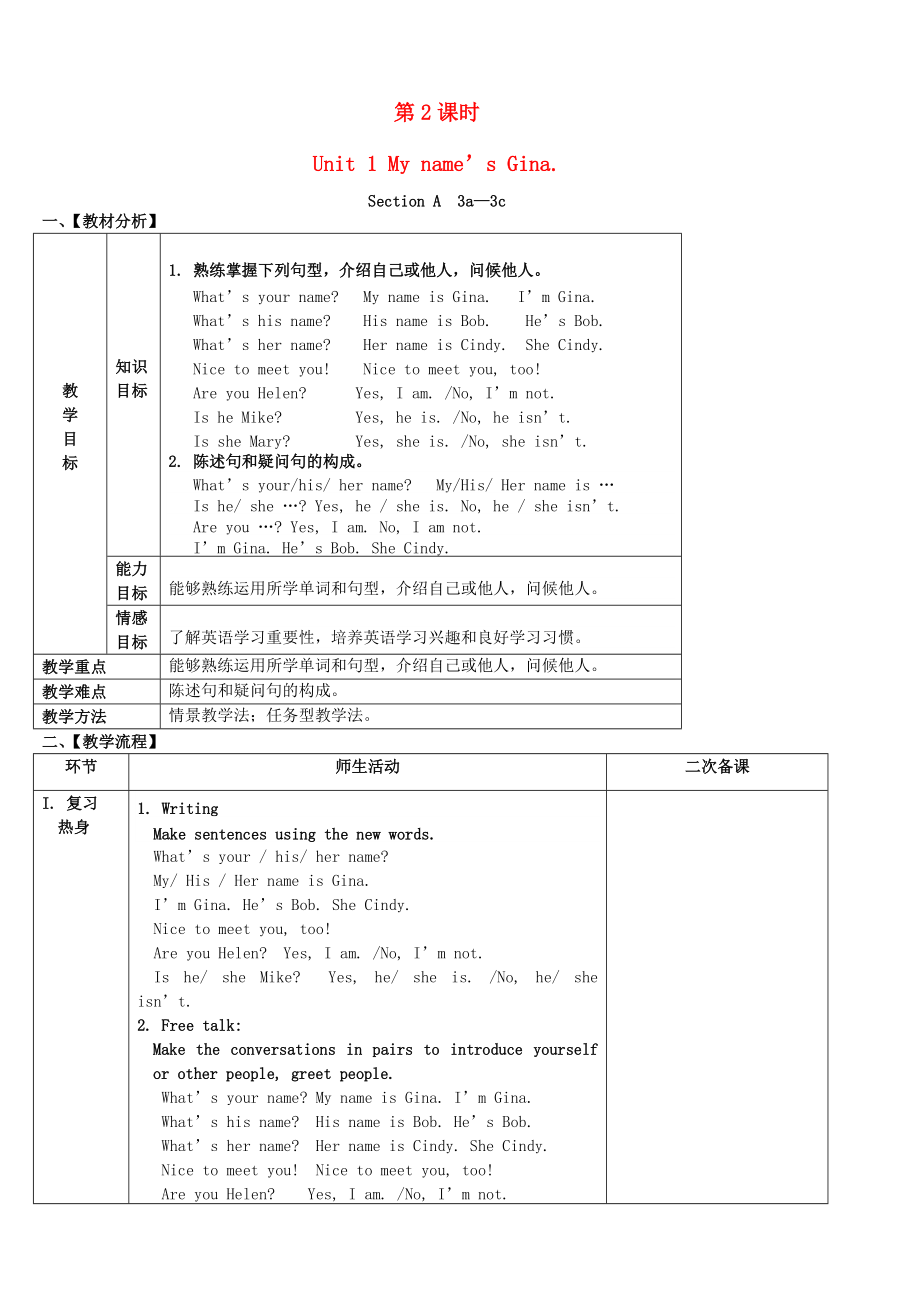《【新人教版英語】七年級上冊導(dǎo)學(xué)案:Unit1Myname’sGina(第2課時(shí))》由會(huì)員分享��,可在線閱讀�����,更多相關(guān)《【新人教版英語】七年級上冊導(dǎo)學(xué)案:Unit1Myname’sGina(第2課時(shí))(3頁珍藏版)》請?jiān)谘b配圖網(wǎng)上搜索��。
1��、第2課時(shí)
Unit 1 My name’s Gina.
Section A 3a—3c
一����、【教材分析】
教
學(xué)
目
標(biāo)
知識(shí)
目標(biāo)
1. 熟練掌握下列句型����,介紹自己或他人����,問候他人����。
What’s your name? My name is Gina. I’m Gina.
What’s his name? His name is Bob. He’s Bob.
What’s her name? Her name is Cindy. She Cindy.
Nice to meet y
2、ou! Nice to meet you, too!
Are you Helen? Yes, I am. /No, I’m not.
Is he Mike? Yes, he is. /No, he isn’t.
Is she Mary? Yes, she is. /No, she isn’t.
2. 陳述句和疑問句的構(gòu)成�。
What’s your/his/ her name? My/His/ Her name is …
Is he/ she …? Yes, he / she is. No, he / she is
3、n’t.
Are you …? Yes, I am. No, I am not.
I’m Gina. He’s Bob. She Cindy.
能力
目標(biāo)
能夠熟練運(yùn)用所學(xué)單詞和句型�,介紹自己或他人,問候他人�。
情感
目標(biāo)
了解英語學(xué)習(xí)重要性,培養(yǎng)英語學(xué)習(xí)興趣和良好學(xué)習(xí)習(xí)慣�。
教學(xué)重點(diǎn)
能夠熟練運(yùn)用所學(xué)單詞和句型,介紹自己或他人�,問候他人。
教學(xué)難點(diǎn)
陳述句和疑問句的構(gòu)成�。
教學(xué)方法
情景教學(xué)法;任務(wù)型教學(xué)法�。
二、【教學(xué)流程】
環(huán)節(jié)
師生活動(dòng)
二次備課
I. 復(fù)習(xí)
熱身
1. W
4����、riting
Make sentences using the new words.
What’s your / his/ her name?
My/ His / Her name is Gina.
I’m Gina. He’s Bob. She Cindy.
Nice to meet you, too!
Are you Helen? Yes, I am. /No, I’m not.
Is he/ she Mike? Yes, he/ she is. /No, he/ she isn’t.
2. Free talk:
Make the conver
5�、sations in pairs to introduce yourself or other people, greet people.
What’s your name? My name is Gina. I’m Gina.
What’s his name? His name is Bob. He’s Bob.
What’s her name? Her name is Cindy. She Cindy.
Nice to meet you! Nice to meet you, too!
Are you Helen? Yes, I am. /No, I’m
6���、not.
Is he Mike? Yes, he is. /No, he isn’t.
Is she Mary? Yes, she is. /No, she isn’t.
II. 感知
體驗(yàn)
1. 學(xué)習(xí)陳述句和疑問句:
(一)陳述句:用來說明事實(shí)或說話人的看法。由“主語(人或物)+ 動(dòng)詞 + ……”構(gòu)成��。
I am Linda. She is Jenny. He is Bob. It is red. My name is Jack.
(二)疑問句:用于提出疑問���。七年級重點(diǎn)學(xué)習(xí)一般疑問句和特殊疑問句�。
一般疑問句由“Is
7���、/ Are / Am + 主語 + …?”構(gòu)成���。它為人們提供了一定的信息,所以回答時(shí)只用Yes或No確認(rèn)即可����,不需要用陳述句回答。如:
Are you Helen? Yes, I am. No, I’m not.
Is he Jack? Yes, he is. No, he isn’t.
特殊疑問句由“疑問詞+ is / are / am + 主語 + …?”構(gòu)成��?;卮饡r(shí)需要用陳述句回答,不可用Yes或No���。如:
What’s your name? My name is Gina.
What’s this���? It’s a key.
What col
8���、or is it? It’s blue.
How are you? I’m fine.
2.Grammar Focus (Page 3)
(1) Look at the chart about Grammar Focus. Read and translate. Talk about the rules of the General Questions and Special Questions.
(2) 縮略詞
what’s =what is name’s = name is I’m = I am
he’s = he is s
9、he’s = she is
III.強(qiáng)化
鞏固
1. Put the words in order to make conversations. Then practice them. (3a)
1. What’s your name? I’m Cindy.
2. What’s his name? He’s Bob.
3. Are you Mike? Yes, I am.
2. Complete the conversation and practice it in pairs.
(3b)
A: Hi, what’s your name?
10���、
B: My name’s Gina. Are you Bill?
A: No, I’m not.
B: Hi, Bob. Nice to meet you!
A: Nice to meet you, too!
Ⅵ. 實(shí)踐
應(yīng)用
Game: Practice introducing yourself and others in a group. How many names can you remember?
A: My name is Dale.
B: His name is Dale. My name is Linda.
C: His name is Da
11�、le. Her name is Linda.
My name is Frank.
D: His name is Dale. Her name is Linda.
His name is Frank. My name is Grace.
Notes: 初學(xué)時(shí)����,名字一定分清男名或女名,這決定著限定詞his/ her的選擇���。
Ⅶ.總結(jié)
反饋
1. 結(jié)合Grammar Focus����,讓學(xué)生自己觀察和述說所學(xué)陳述句和疑問句的結(jié)構(gòu)����。
2. Writing and remember the sentences.
What’s your / his/ her name?
My/ Hi
12、s / Her name is Gina.
I’m Gina. He’s Bob. She Cindy.
Nice to meet you, too!
Are you Helen? Yes, I am. /No, I’m not.
Is he/ she Mike? Yes, he/ she is. /No, he/ she isn’t.
Ⅷ.作業(yè)
布置
熟練運(yùn)用所學(xué)單詞和句型����,介紹自己或他人,問候他人����。
三、【板書設(shè)計(jì)】
Unit 1 My name’s Gina. Section A 3a—3c
四��、【教后反思】
 【新人教版英語】七年級上冊導(dǎo)學(xué)案:Unit1Myname’sGina(第2課時(shí))
【新人教版英語】七年級上冊導(dǎo)學(xué)案:Unit1Myname’sGina(第2課時(shí))

